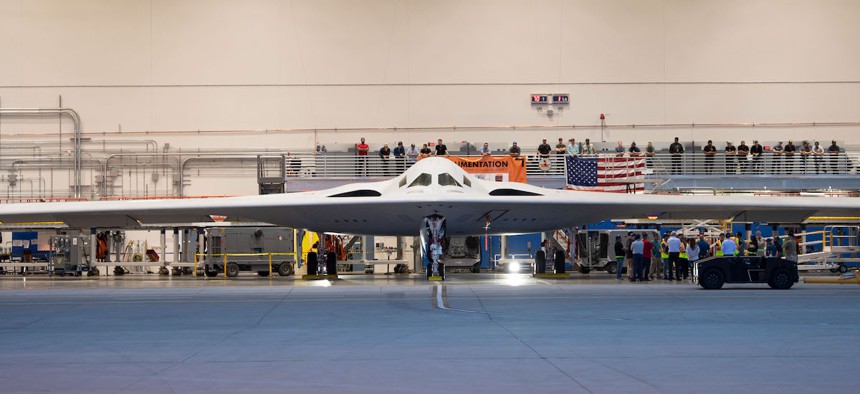
U.S. Air Force B-21 Raider bomber, shown on July 31, 2023. Secretary of the Air Force Public Affairs
B-21 starts engine tests as bomber preps for first flight
Software is ready to go, program officials say, engendering some 'smack talk' with hardware teams.
Engine tests have begun on the B-21 Raider, the Air Force stealth bomber slated for first flight later this year.
The engine runs are part of B-21 ground tests at planemaker Northrop Grumman’s facility in Palmdale, California. Three more photos of the secretive plane were released on Wednesday, adding to the handful released at the aircraft’s rollout last December.
Less than a week passed between fueling the B-21 for the first time to starting its engines, said William Bailey, who leads the Air Force’s Rapid Capabilities Office.
“We went from fuel to engine run in less than five days. If you’ve been in the business that's usually measured in weeks—if not more,” Bailey said Wednesday at the Air & Space Forces Association’s annual Air, Space & Cyber conference.
The software team has all the code it needs for the first flight, and the program is now waiting on the hardware to catch up before the first flight can happen.
“It's not fun to watch engineers smack talk, but between the software guys and the hardware guys, they're saying. ‘Would you please hurry up? We're done’,” Bailey said.
The first B-21, “for all intents and purposes” is a “production jet,” said Tom Jones, president of Northrop’s Aeronautics Systems. Treating the first test jet like a production jet will “pay dividends” because they can learn as they go, “which in the long run is going to lead to a much better transition to production,” Jones said.
Asked about final hurdles before its first flight, Jones told Defense One the company is now in the final stages, “as we need to be if we're going to get that first flight in by the end of this year.”
That’s still the Air Force’s plan, even if Secretary Frank Kendall expressed some doubts in March. On Monday, Kendall told reporters at the conference that he’s “still hopeful” it will fly this year.
“We're going through a number of things to get ready for first flight. They all have to happen and there is always risk in developing programs. Something can surprise you,” the secretary said.
The Air Force envisions B-21s operating with collaborative combat aircraft, or CCAs, future drones that will fly alongside manned fighters. Kendall said CCAs could fly ahead of B-21s and provide defensive capabilities.
The stealth bomber will be “part of a family of systems,” Jones said, and the program’s “interconnectedness” is what makes it a sixth-generation platform.
“In terms of building capability, we've designed this system to have a very open architecture. It's got a very modern, agile based software architecture, really taking a lot of the best practices out of commercial industry, and defense firms,” Jones said.




